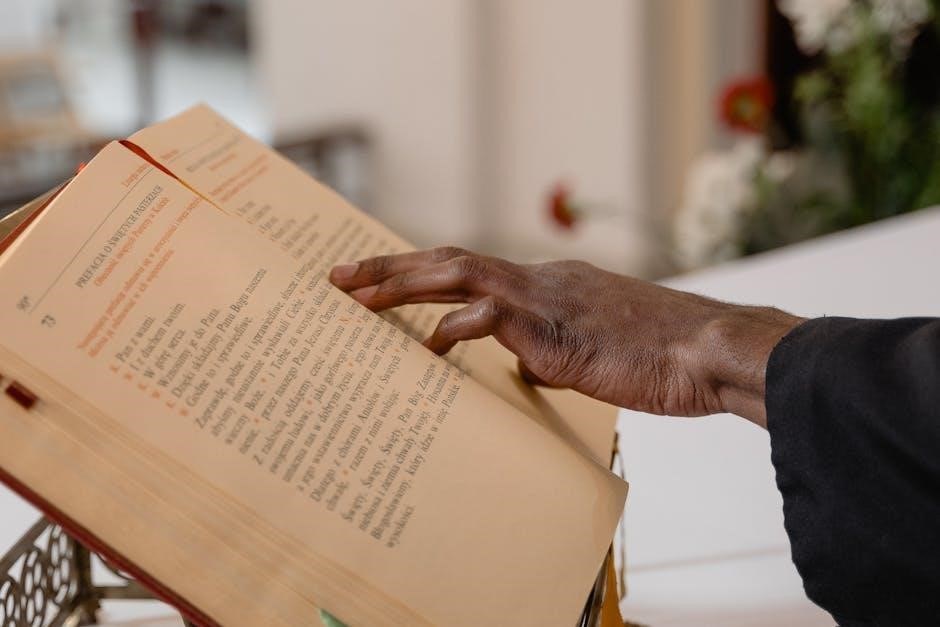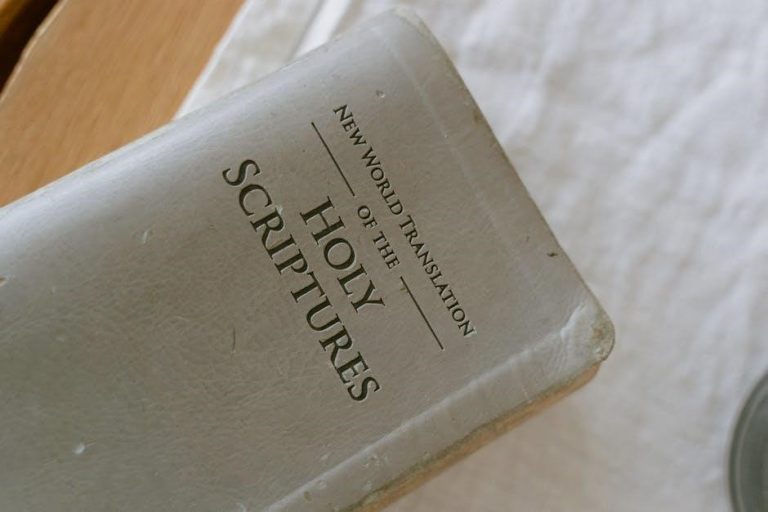The Divine Prayer, known as the Chaplet of Divine Mercy, was introduced by Saint Faustina Kowalska. PDF guides provide step-by-step instructions for praying this powerful devotion.
Overview of the Divine Prayer and Its Significance
The Divine Prayer, rooted in Catholic tradition, is a devotion focused on seeking God’s mercy and fostering trust in His divine plan. Originating from the visions of Saint Faustina Kowalska, it emphasizes the limitless mercy of Jesus Christ. The prayer is typically recited using rosary beads, with a structure that includes opening prayers, a novena, and a closing prayer. Its significance lies in its ability to deepen one’s spiritual connection and request divine intervention. Many find solace in its promises of grace and spiritual growth. PDF guides are widely available, offering detailed instructions for those seeking to incorporate this powerful devotion into their daily prayer life.

The Chaplet of Divine Mercy
The Chaplet of Divine Mercy is a Catholic devotion prayed on rosary beads, emphasizing God’s mercy and trust in His divine plan. PDF guides provide easy instructions;
Structure of the Chaplet of Divine Mercy
The Chaplet of Divine Mercy is prayed on standard rosary beads, consisting of five decades. It begins with the Sign of the Cross and two opening prayers from Saint Faustina’s diary. Each decade includes the repetition of the prayer: “For the sake of His sorrowful Passion, have mercy on us and on the whole world.” This is followed by the Eternal Father prayer, which honors the sacrifice of Jesus. After completing all five decades, the Chaplet concludes with a closing prayer. The structure is simple, making it accessible for devotion. PDF guides provide clear instructions for reciting the Chaplet, ensuring its proper execution and spiritual benefits.
The Opening Prayers from the Diary of Saint Faustina
The Chaplet begins with two opening prayers from Saint Faustina’s diary. These prayers set the tone for the devotion, emphasizing trust in God’s mercy. The first prayer is the Eternal Father, which implores divine mercy for the entire world. The second prayer is the Divine Mercy, expressing trust in God’s boundless love. These prayers, rooted in Saint Faustina’s revelations, connect the petitioner to the divine. PDF guides often include these prayers, ensuring their proper recitation. They are essential for invoking the grace promised by Jesus through the Chaplet. The opening prayers are a beautiful expression of reliance on divine compassion and forgiveness.
The Closing Prayer of the Chaplet
The Chaplet concludes with a powerful closing prayer that encapsulates the devotion’s core message of trust and surrender. The prayer invokes Divine Mercy to envelop the world, emphasizing its boundless and life-giving nature. It reflects on the sacrifice of Christ, whose blood and water symbolize mercy and redemption. The closing prayer is a heartfelt plea for God’s compassion to flow into souls, reinforcing the Chaplet’s promise of grace. PDF guides often highlight this prayer, ensuring its proper recitation. It serves as a final expression of faith, sealing the petitioner’s trust in divine love and mercy, and calling for its outpouring upon humanity.

Prayers and Devotions
The Divine Prayer PDF includes traditional prayers like the Our Father, Hail Mary, and Apostles’ Creed, along with the Chaplet and novena, fostering a deep connection to divine mercy and grace.
The Our Father, Hail Mary, and Apostles’ Creed in the Chaplet
The Chaplet of Divine Mercy begins with the traditional prayers of the Our Father, Hail Mary, and Apostles’ Creed, which are deeply rooted in Catholic devotion. These prayers, taken from the Diary of Saint Faustina, serve as an invocation of divine mercy and a profession of faith. The Our Father is prayed to align oneself with God’s will, while the Hail Mary seeks the intercession of the Blessed Virgin Mary. The Apostles’ Creed reaffirms belief in the Holy Trinity and the mysteries of the faith. Together, these prayers create a foundation for the Chaplet, emphasizing trust in God’s mercy and the unity of the prayer with Catholic tradition.
The Novena Prayers Associated with the Chaplet
The Novena of Divine Mercy is a nine-day prayer devotion that precedes Divine Mercy Sunday. It begins on Good Friday and ends on the eve of Divine Mercy Sunday. Each day of the Novena focuses on a specific group of souls, such as all humanity, the faithful, and those in purgatory. The Novena prayers, as revealed to Saint Faustina, are prayed daily, followed by the Chaplet of Divine Mercy. These prayers emphasize intercession for the salvation of souls and immersion in God’s infinite mercy. PDF guides are available, providing the daily Novena prayers and intentions, making it accessible for all to participate deeply in this sacred devotion.
The Divine Mercy in Catholic Tradition
The Divine Mercy is a cornerstone of Catholic devotion, emphasizing God’s infinite compassion. It is deeply rooted in the revelations to Saint Faustina, promoting trust in God’s mercy. The tradition includes the Chaplet, the Divine Mercy image, and the celebration of Divine Mercy Sunday, reflecting the Church’s commitment to spreading mercy and forgiveness globally. PDF resources provide detailed guidance on these practices, enriching the spiritual journey of the faithful.
The Role of Saint Faustina Kowalska in Promoting Divine Mercy
Saint Faustina Kowalska, a Polish nun, played a pivotal role in spreading the Divine Mercy devotion. Through her visions and diary entries, she shared the message of God’s infinite mercy and compassion. She introduced the Chaplet of Divine Mercy, a prayer revealed to her by Jesus, and emphasized the importance of trusting in His mercy. Her writings and teachings led to the establishment of Divine Mercy Sunday and the veneration of the Divine Mercy image. Faustina’s canonization in 2000 further solidified her role as a messenger of mercy in the Catholic Church, inspiring millions to embrace this powerful devotion.
The Theological Basis of Divine Mercy
The Divine Mercy devotion is rooted in the Catholic understanding of God’s infinite love and forgiveness. It emphasizes that mercy is a fundamental attribute of God, reflecting His willingness to forgive and show compassion. The Chaplet of Divine Mercy, revealed to Saint Faustina, serves as a prayerful response to this divine attribute. Theologically, it is grounded in the sacrifice of Christ, who poured out His life for the salvation of humanity. The devotion underscores the free gift of mercy, accessible to all, and encourages believers to trust in God’s goodness and seek conversion. This prayer expresses the Church’s teachings on redemption and divine love.

Benefits of Praying the Divine Mercy Chaplet
Praying the Chaplet brings trust in God’s mercy, peace in times of sorrow, and grace for spiritual and personal transformation, fostering a deeper connection with the Divine.
Promise of Grace and Mercy Through the Chaplet
The Chaplet of Divine Mercy is deeply rooted in the promise of God’s infinite grace and mercy. Saint Faustina Kowalska, the visionary behind this devotion, recorded in her diary that Jesus promised great graces to those who pray the Chaplet. He assured her that the Chaplet would bring unforgettable mercy to souls, especially when prayed with trust and sincerity. The promises include relief for the suffering, strength for the weak, and eternal blessings for those who trust in His mercy. This sacred prayer is a powerful means to experience God’s compassion and forgiveness, offering hope and consolation to all who recite it.
Personal Testimonies of Spiritual Growth Through the Chaplet
Many believers have shared profound testimonies of spiritual growth through the Chaplet of Divine Mercy. Countless individuals have reported feeling a deeper connection to God, experiencing inner peace, and finding solace in times of suffering. The Chaplet has been credited with transforming lives, fostering forgiveness, and strengthening faith. Some have shared stories of miraculous healing, both physical and emotional, after praying the Chaplet with trust and devotion. These personal accounts highlight the Chaplet’s power to bring people closer to God and deepen their spiritual journey. Such testimonies inspire others to embrace this devotion, finding hope and renewal through its prayers.
How to Pray the Chaplet of Divine Mercy
Begin with the Sign of the Cross, then pray the Our Father, Hail Mary, and Apostles’ Creed. Recite the Eternal Father prayer for each decade, ending with “For the sake of His sorrowful Passion, have mercy on us and on the whole world.” Conclude with three repetitions of “Holy God, Holy Mighty One, Holy Immortal One, have mercy on us and on the whole world.” This simple yet profound prayer structure offers a powerful way to seek divine mercy and grace.
A Step-by-Step Guide to Reciting the Chaplet
Begin by making the Sign of the Cross. Pray the Our Father, Hail Mary, and Apostles’ Creed. On each of the 50 beads, recite the Eternal Father prayer, ending with “For the sake of His sorrowful Passion, have mercy on us and on the whole world;” After five decades, repeat three times: “Holy God, Holy Mighty One, Holy Immortal One, have mercy on us and on the whole world.” Conclude with the Closing Prayer from Saint Faustina’s diary. Optional additions include the Divine Mercy Litany or novena prayers. PDF guides are available for easy reference, ensuring a proper and meaningful recitation of the Chaplet.
Optional Prayers and Devotions to Enhance the Chaplet
To deepen your devotion, consider adding optional prayers such as the Divine Mercy Litany or novena prayers. These can be recited before or after the Chaplet, offering a richer spiritual experience. The novena, spanning nine days, includes specific daily intentions and prayers. Additionally, incorporating reflections from Saint Faustina’s diary or singing hymns like “Abyss of Mercy” can enhance your prayer time. Many PDF guides include these optional devotions, making it easy to incorporate them into your routine. These additions allow for a more personalized and profound connection to the Divine Mercy message.

Resources for Learning the Divine Prayer
PDF guides and downloadable resources are available online, offering detailed instructions and prayers for the Chaplet of Divine Mercy. These materials include step-by-step guides, the Divine Mercy Litany, and reflections from Saint Faustina’s diary to enhance your devotion.
PDF Guides and Downloads for the Chaplet of Divine Mercy
Various PDF guides and downloadable resources are available to help individuals learn and pray the Chaplet of Divine Mercy. These guides often include step-by-step instructions, the full text of the Chaplet, and accompanying prayers such as the Divine Mercy Litany and novena prayers. Many resources also feature reflections and excerpts from Saint Faustina’s diary, offering deeper insight into the devotion. Additionally, some PDFs provide visual aids, such as diagrams for praying the Chaplet on rosary beads. These materials are easily accessible online and are ideal for personal or communal prayer. The Vatican has also released a free prayer book, further enhancing access to this powerful devotion.




